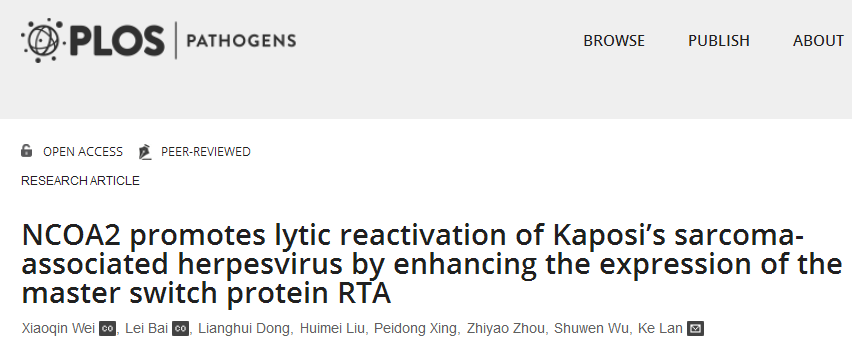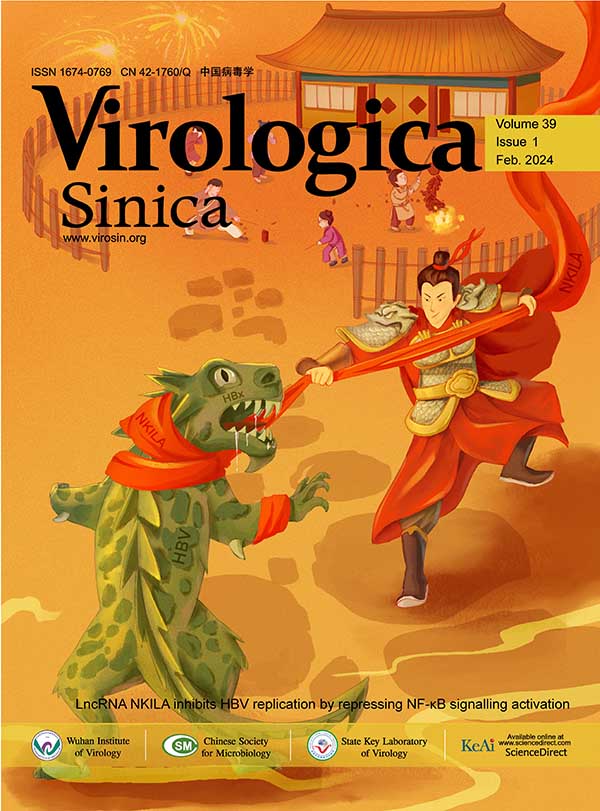
卡波氏肉瘤相关疱疹病毒(Kaposi’s sarcoma-associated herpesvirus, KSHV)是一种重要的人类肿瘤病毒,是引起卡波氏肉瘤、原发性渗出性淋巴瘤以及多中心性卡斯特曼病等多种恶性肿瘤的病因。KSHV通常能在其感染的绝大部分细胞中建立潜伏感染,当机体处于应急、缺氧、免疫力下降等特定的病理生理条件时,KSHV可被诱导由潜伏感染进入再激活裂解复制。在再激活裂解复制期,大量病毒基因表达,产生有感染性的病毒粒子,感染新的宿主细胞,以维持病毒在宿主体内的潜伏库。病毒蛋白RTA是调控KSHV潜伏感染和再激活裂解复制两相生命周期转换的关键开关分子,目前对于RTA如何被宿主分子调控的机制尚未完全阐明。
蓝柯研究组长期从事KSHV生命周期调控及致瘤机制研究。为探索宿主分子对RTA的调控作用,他们通过质谱等技术筛选到一个新的RTA结合蛋白NCOA2。研究发现,在KSHV再激活裂解复制的过程中,NCOA2被RTA招募至其C末端的PARS II 结构域,从而抑制MDM2介导的RTA蛋白酶体途径的泛素化降解,使得RTA表达更加稳定,最终促进KSHV再激活裂解复制的完成(图1)。该研究阐明了宿主蛋白NCOA2参与调控KSHV裂解复制的功能机制,为设计靶向KSHV再激活裂解复制的抗病毒策略提供了新的线索。
图1:NCOA2通过增强RTA的表达促进KSHV的裂解复制
武汉大学生命科学学院博士研究生魏小琴和白磊博士为该论文的共同第一作者,蓝柯教授为该论文的通讯作者。该研究得到了国家重点研发计划以及国家杰出青年科学基金等项目的资助。
原文链接:
https://journals.plos.org/plospathogens/article?id=10.1371/journal.ppat.1008160
Abstract: Reactivation of Kaposi’s sarcoma-associated herpesvirus (KSHV) is important for persistent infection in the host as well as viral oncogenesis. The replication and transcription activator (RTA) encoded by KSHV ORF50 plays a central role in the switch from viral latency to lytic replication. Given that RTA is a transcriptional activator and RTA expression is sufficient to activate complete lytic replication, RTA must possess an elaborate mechanism for regulating its protein abundance. Previous studies have demonstrated that RTA could be degraded through the ubiquitin-proteasome pathway. A protein abundance regulatory signal (PARS), which consists of PARS I and PARS II, at the C-terminal region of RTA modulates its protein abundance. In the present study, we identified a host protein named Nuclear receptor coactivator 2 (NCOA2), which can interact with RTA in vitro and in vivo. We further showed that NCOA2 binds to the PARS II domain of RTA. We demonstrated that NCOA2 enhances RTA stability and prevents the proteasome-mediated degradation of RTA by competing with MDM2, an E3 ubiquitin ligase of RTA that interacts with the PARS II domain. Moreover, overexpression of NCOA2 in KSHV-infected cells significantly enhanced the expression level of RTA, which promotes the expression of RTA downstream viral lytic genes and lytic replication. In contrast, silencing of endogenous NCOA2 downregulated the expression of viral lytic genes and impaired viral lytic replication. Interestingly, we also found that RTA upregulates the expression of NCOA2 during lytic reactivation. Taken together, our data support the conclusion that NCOA2 is a novel RTA-binding protein that promotes RTA-driven lytic reactivation by increasing the stability of RTA, and the RTA-NCOA2 positive feedback regulatory loop plays an important role in KSHV reactivation.



















